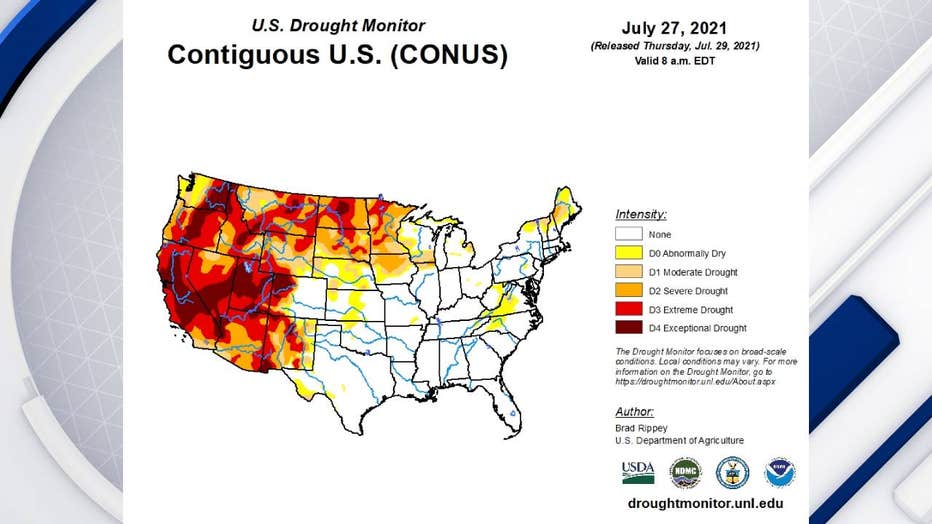Drought persists but recent rain has impact across Arizona

Morning Weather Forecast - 7/29/21
A mix of sun and clouds today in the Valley with a high near 105°
TUCSON, Ariz. - Drought conditions still exist across Arizona but recent monsoon rain has had a significant impact for the better.
The latest drought monitor "shows substantial improvement" in the two most severe drought categories, now reporting 52% of Arizona in either extreme or exceptional drought, down from 84% last week, the National Weather Service office in Phoenix said on July 29.

U.S. drought monitor map (droughtmonitor.unl.edu)
The month isn’t even over yet and Tucson has already recorded its wettest July in the city’s history.
The southern Arizona city received 7.08 inches (18 centimeters) of rain as of Wednesday, according to the National weather service.
That breaks July’s previous record of 6.8 inches (17 centimeters) set in 2017.
Because of an active monsoon season, Tucson has been hit with more than 5 inches (13 centimeters) of rain since last Friday.
Meteorologists said the normal rainfall amount for Tucson in July is about 2 inches (5 centimeters).
Meanwhile, Phoenix has received 1.67 inches (4 centimeters) of rain so far this month, its wettest July since 2013.
Download the FREE FOX 10 Weather App
More monsoon coverage
Featured
Cleanup efforts continue in Scottsdale following powerful monsoon storms
The post-monsoon cleanup in Scottsdale has been ongoing for several days, since last round of storm left a trail of damage in the East Valley city.
Featured
Wall of dust blankets Phoenix during busy monsoon season
With Arizona's active monsoon season comes dangerous walls of dust over the state, clouding drivers' vision and blanketing cars and homes.
Featured
Is Arizona's active monsoon season helping the decades-long drought?
Climate and water experts say although the monsoon storms have been great, they put a small dent in a decades-long drought Arizona has been in.
Tune in to FOX 10 Phoenix for the latest news:
Preventing heat exhaustion/heat stroke
The Arizona Department of Health Services stated the following precautions can be taken to prevent heat exhaustion or heat stroke:
- Stay in air-conditioned buildings
- Limit outdoor activity during the hottest part of the day (mid-day)
- Check on at-risk friends, family, and neighbors at least twice a day
- Drink water before, during, and after working or exercising outside
Driving in extreme temperatures
The Arizona Department of Transportation’s tips for driving in extreme temperatures include:
Have sun protection: In addition to an umbrella, take sunscreen and a wide-brimmed hat and wear loose-fitting, light-colored cotton clothing.
Fuel up: Keep your tank at three-quarters full. Running out of gas, especially in a remote location, is dangerous in extreme heat.
Hydrate: Take a cooler to keep extra drinking water cold, and consider adding several frozen bottles of water to use for cooling off or to thaw and drink if needed. Make sure everyone, including pets, stays hydrated.
Get help: If your vehicle breaks down in extreme heat, call for assistance right away to reduce wait time, and run the AC. If the AC isn’t working, roll down all windows.
Wait safely: If the temperature inside your vehicle becomes too hot, everyone, including pets, should exit carefully and seek out or create a shaded area as far away from the travel lanes as possible. Be careful walking on the road surface, which can be hot enough to burn skin. Keep your shoes on and try to keep your pets’ paws off the pavement. If you are stopped along the highway, raise the front hood and turn on hazard lights. Please keep in mind that parking in tall brush can start a fire.
Check your vehicle: You can help avoid breakdowns and blowouts by making sure your vehicle is in good operating condition. Check your air conditioner and coolant levels, top off any vital engine fluids and make sure your battery is up to par. Check your tire pressure, as the combination of under inflated tires and hot pavement can lead to a blowout.
MORE: https://azdot.gov/about/transportation-safety/severe-weather
Be prepared and stay safe during the monsoon
"Most Valley residents know how quickly and furiously storms can move in and out, bringing strong winds, dust, rain, and flash flooding. These storms can cause interruptions in services, such as water, power, and gas," stated Captain Ashley Losch of the Glendale Fire Department.
GFD reminds residents of ways they can be prepared and stay safe:
- Have flashlights with extra batteries on hand.
- Have food that can be prepared without the need for cooking or refrigeration.
- Have at least one gallon of clean water for each person in the household.
- Have backup power for anyone requiring power for a medical device.
- Have backup power for cell phones that do not require charging.
- Have a first aid kit ready and accessible.
- Never drive into areas with flowing water; it takes less than 10 inches to wash a car away.
- Avoid flooded areas, such as washes.
- If waters are rising, seek higher ground.
- Do not approach downed power lines, the ground can be energized for up to 200 feet.
- Keep pets indoors during storms.





